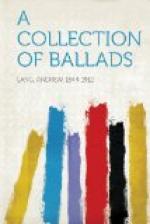SIR HUGH
The date of the Martyrdom of Hugh is attributed by Matthew Paris to 1225. Chaucer puts a version in the mouth of his Prioress. No doubt the story must have been a mere excuse for Jew-baiting. In America the Jew becomes “The Duke” in a version picked up by Mr. Newells, from the recitation of a street boy in New York. The daughter of a Jew is not more likely than the daughter of a duke to have been concerned in the cruel and blasphemous imitation of the horrors attributed by Horace to the witch Canidia. But some such survivals of pagan sorcery did exist in the Middle Ages, under the influence of “Satanism.”
SON DAVIE
Motherwell’s version. One of many ballads on fratricide, instigated by the mother: or inquired into by her, as the case may be. “Edward” is another example of this gloomy situation.
THE WIFE OF USHER’S WELL
Here
“The cock doth craw, the day doth daw,”
having a middle rhyme, can scarcely be of extreme antiquity. Probably, in the original poem, the dead return to rebuke the extreme grief of the Mother, but the poem is perhaps really more affecting in the absence of a didactic motive. Scott obtained it from an old woman in West Lothian. Probably the reading “fashes,” (troubles), “in the flood” is correct, not “fishes,” or “freshes.” The mother desires that the sea may never cease to be troubled till her sons return (verse 4, line 2). The peculiar doom of women dead in child-bearing occurs even in Aztec mythology.
THE TWA CORBIES
From the third volume of Border Minstrelsy, derived by Charles Kirkpatrick Sharpe from a traditional version. The English version, “Three Ravens,” was published in Melismata, by T. Ravensworth (1611). In Scots, the lady “has ta’en another mate” his hawk and hound have deserted the dead knight. In the English song, the hounds watch by him, the hawks keep off carrion birds, as for the lady—
“She buried him before the prime, She was dead herselfe ere evensong time.”
Probably the English is the earlier version.




